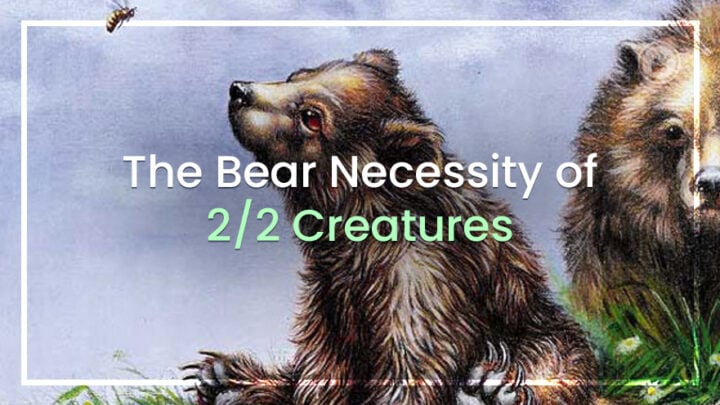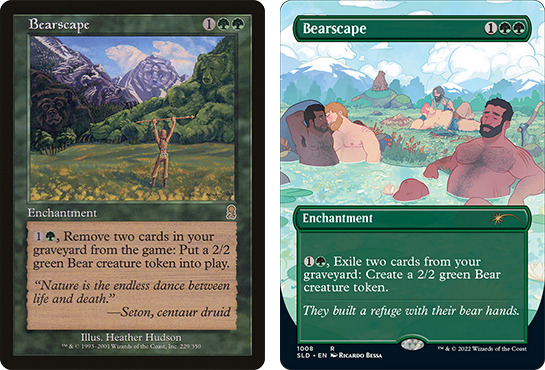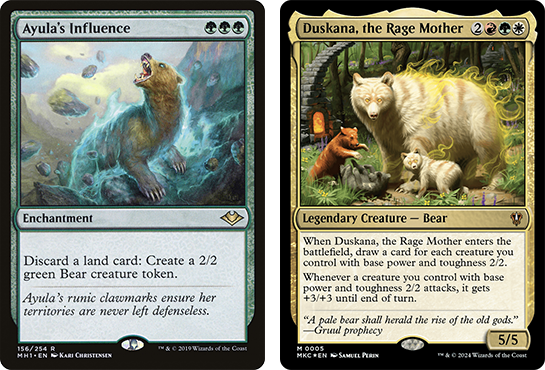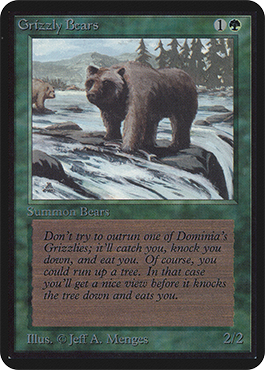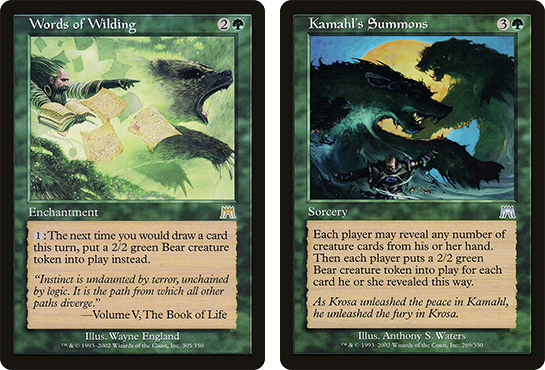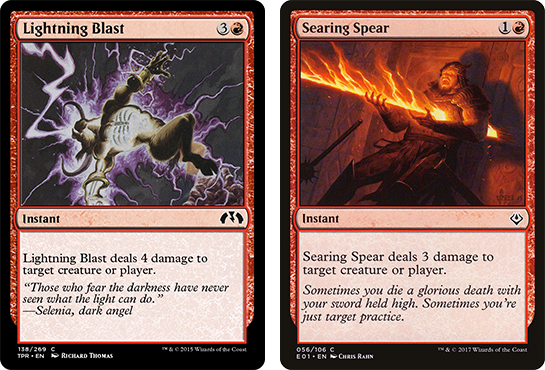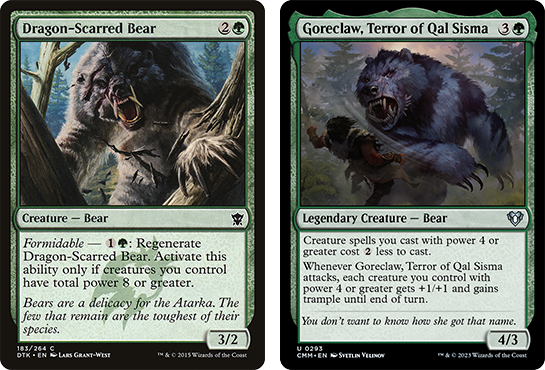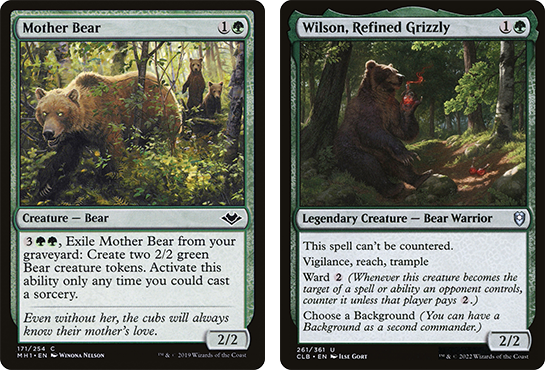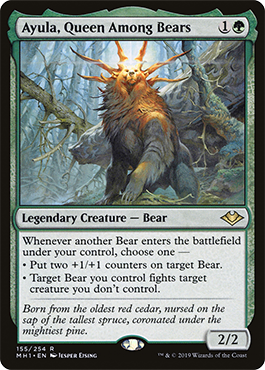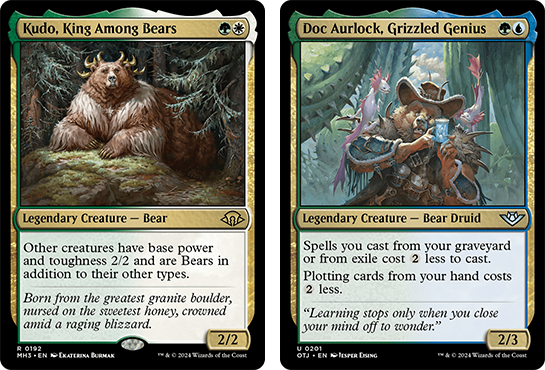If you ask “why is ‘bear’ accepted Magic slang for a 2/2 creature?”, the answer is simple. Grizzly Bears was printed as a vanilla 2/2 in Limited Edition Alpha and set the precedent for describing similar low-complexity combat creatures.
But maybe that answer isn’t good enough, and you ask: “no, I mean why would that term be the one to stick? Why do 2/2s – or even more specifically, 2/2s for two mana – need their own special terminology? And why would that term have such staying power that 30 years later designers go out of their way to reinforce the connection between 2/2s and bears even as the context around them has been drastically redefined by power creep?
These deeper and more philosophical questions show how building a consistent design language has helped hold this sprawling game together over the years, and how a shared understanding of that language contributes to a shared culture and camaraderie in the playerbase.
There’s a reason cards like Ayula’s Influence, Duskana, the Rage Mother and Kudo, King Among Bears are still being made, and always get a positive reception from the community. And it all comes back to the OG.
A GRIZZLY TALE
There’s absolutely nothing unique about Grizzly Bears as a game object; not even its sheer generic-ness. Ironclaw Orcs is also a 2/2 for two from Limited Edition Alpha, and that saw enough play to make the 2nd placed decklist at Worlds 1998. So why don’t we call them “Orcs” instead?
One reason is longevity: Ironclaw Orcs weren’t reprinted after Fifth Edition, while Grizzly Bears continued to reappear in every core set for another 10 years! Personally though, I think the concept and presentation of Grizzly Bears helped elevate it to meme status. The Alpha card art shows a stocky, ominous animal posed in a very natural-looking habitat. It looks like it could be in a geography textbook.
There’s an unspoken comedy to the idea of a wizard summoning otherworldly dragons and devils and djinn to do battle… and they’re pitted against A Normal Bear. The excellent flavor text doubles down on the joke, waxing lyrical about the Ordinary Bear’s status as an alpha predator.
Nevermind that even in Alpha, it was outclassed by more powerful or efficient beasts like War Mammoth. That memorable presentation cemented Grizzly Bears as an icon of early Magic. When Ice Age decided to functionally reprint Grizzly Bears in 1995, the flavor made sense if the new card was a bear as well – and then threw in a bonus islandwalking bear to boot (still a 2/2)!
The trend continued in any beginner-oriented set which needed a vanilla 2/2 for two: Portal 2nd Age used Bear Cub, while Portal Three Kingdoms gave us Forest Bear. Meanwhile expansion sets like Weatherlight began to experiment with ways to broaden the utility of creatures like Striped Bear while keeping their recognizable 2/2 statline – a project which continues to this day.
Not every bear printed then or now has been 2/2, but there is an obvious long-term pattern of Magic designers pushing to have 2/2 green creatures printed as bear-types, and vice versa. If a new enchantment needed to make 2/2 green tokens, there was at least a 50/50 chance the designers would make them bears just out of habit!
But why is that? Why jump through hoops to try and balance a deck full of 2/2s for commander with cards like Duskana, the Rage Mother, or Ayula, Queen Among Bears?
JUST BEAR WITH ME HERE
Even in its early days with the card pool a fraction of the size it is today, Magic was a challenging game for a novice to learn. Since it was the card game to really explore the possibilities of custom deckbuilding, players were not yet practiced or comfortable with holding details of every relevant spell in their minds.
The new, abstract-feeling game concepts needed to be closely associated with flavor and visual to help players remember. The color pie forms a foundational layer to this design language, assigning each color unique flavor and mechanical aspects to form its identity. New players in any year have been quick to learn that cards depicting elemental fire or lightning blasts are always red, and that they almost always take the form of instants or sorceries which deal direct damage to a target.
By staying true to those associations in future sets, Wizards makes it easier for new players remembering cards and veterans talking about design: druids tap for green, angels have flying, targeted discard is on black cards. And a “bear” is a 2/2 creature with few or no abilities, at least none that matter outside of combat (the one druid bear obviously being the exception that proves the rule).
That matters because for at least the first half of Magic history, 2/2 for two was THE most important stat line for game balance. Dealing damage in increments of two was seen as leading to a desirable pace of play. Meanwhile, the jump from two to three toughness marked the dividing line between “small” and “large” creatures – it’s why Lightning Bolt was swapped out for Shock in core sets, and why early sweepers like Pyroclasm and Evincar’s Justice hit for two damage.
As people spent years talking more fluently about the game and the pool of cards became larger and less unique, “regular, average bear” eventually became shorthand for any “regular, average creature”, regardless of actual type, color, abilities, or eventually even the specific statline. Safehold Elite is “a bear with persist”. Treasure Dredger is “a bear that makes Treasure”. Eternal Witness (even as a three mana 2/1) is “a bear that Regrows something”.
Eventually this culminated in the enduring term “Hatebear” being coined for cards like Magus of the Moon and Drannith Magistrate which staple powerful restrictive abilities onto small creatures. However, as the use of “bear” in Magic meta-discussion was on the rise, the relevance of actual bears, including Grizzly Bears itself, was in sharp decline.
WHAT’S IT TWO YA?
Yes, some of those “bears” being discussed were still actual examples of furry predators. Time Spiral introduced us to the new flash mechanic by showing off “bear with flash”. M12 took an unusual pairing of design language concepts and created “bear illusion”. Innistrad block offered both “bear with morbid” and “bear with soulbond”, confirming that bears are always a great introductory vehicle for new set mechanics.
But as Magic explored more fantastic and diverse planes and the average size and power level of creatures grew beyond the humble 2/2 for two, it seemed that both halves of that strong “bear” identity would be left behind. Only four bear-type creatures were printed between 2012 and 2019 – and none of them were 2/2s!
Were we really going to just surrender such an important part of Magic’s vocabulary and culture? Sure, it might seem weird to lock in the depiction of these ferocious, fearsome predators at 2/2 in an era where even seagulls are statted more formidably. But why not take that as a design challenge rather than an impediment – find ways to design a creature printed as 2/2 that remains competitive through its abilities.
Now, instead of surrendering a unique strand of the shared language which unites Magic players of all eras, you strengthen that connection AND create the design space for a bear-themed deck to connect together mechanically rather than simply being random 2/2s with similar art!
This momentous leap forward in bear technology was realized with Ayula, Queen Among Bears and Mother Bear in Modern Horizons 1. Not only did these cards (plus Ayula’s Influence) break the drought of bears having 2/2 statlines, but the strong reception from fans ensured future designs that played with the dual identity of “bears”.
Tuya Bearclaw is almost a stronger indication of this pivot for NOT having the bear type. However, she is a 2/2 with a bear in her art, a bear honorific, and her given name is the battlecry of every mage to ever send a Grizzly Bear in for an open attack (“go to combat, I’ll two ya”).
Ruxa, Patient Professor is not a 2/2, but the bear druid is clearly set up to be a commander for a deck of vanilla creatures – leaning into another classic aspect of the bear identity! Wilson, Refined Grizzly is the flipside of that concept – an educated bear who has simply added a haul of keywords (plus a background) to his essential 2/2 frame.
NATURE IS HEALING
Magic in 2024 is arguably doing too many things too quickly to ever recapture the same consistency in design that it had in previous decades. While a consistent design language has been inestimably important to the growth of the game, it’s harder to say what that means when you have Optimus Prime battling across the table with Tyranids, Daleks and the Nine Nazgul.
Sure enough, not every new bear creature we see has a 2/2 statline or cares about 2/2s and vanilla creatures in its text. But at least half of them do, and interestingly it does seem like there’s a tendency for it to be those cards which depict the classic, “normal” bears like Duskana or Kudo, compared to bear-people like Doc Aurlock or hybrids like the new elemental bear, Lumra.
The way I see it, those cards are bears with other stuff going on; they reflect the mechanical identity of their color faction in that set or plane. But when a bear hasn’t got other strong influences, and its identity comes primarily from bear-ness? Then Wizards have repeatedly shown that the historic concept of “bears”, which has been so familiar to Magic for so long, is here to stay and to grow.

Tom’s fate was sealed in 7th grade when his friend lent him a pile of commons to play Magic. He quickly picked up Boros and Orzhov decks in Ravnica block and has remained a staunch white magician ever since. A fan of all Constructed formats, he enjoys studying the history of the tournament meta. He specializes in midrange decks, especially Death & Taxes and Martyr Proc. One day, he swears he will win an MCQ with Evershrike. Ask him how at @AWanderingBard, or watch him stream Magic at twitch.tv/TheWanderingBard.

